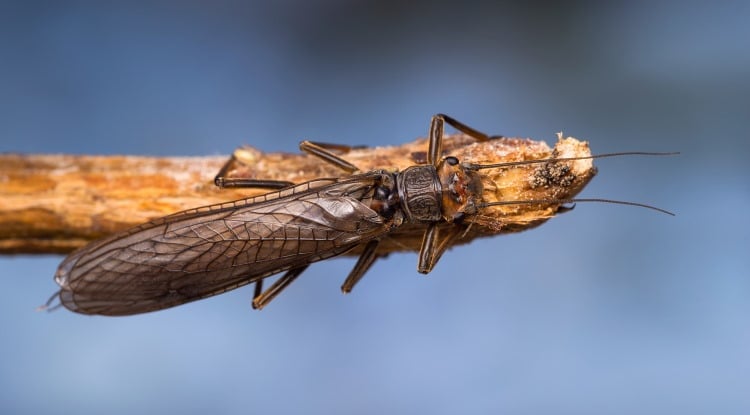Lepidoptera 101: Moths And Butterflies
Lepidoptera 101: Much Loved Order Of The Moths And Butterflies
The Lepidoptera (Butterflies and Moths) are by far the most popular group of insects, in both the mind of the general public and with Entomologists.
There are more books on Lepidoptera (see butterfly books) and more people collecting and working on Lepidoptera – than any other insect order. Everybody loves Butterflies.
The Lepidoptera are one of the five great orders of insects… and when all the counting has been finished, will probably be fighting for 3rd place with the Diptera, behind the Hymenoptera and the Coleoptera, but ahead of the Hemiptera (especially in those taxonomic organisations that split the Hemiptera into 2 orders).
There are about 150,590 named species according to The Catalogue of Life as of March 2021. Most (more than 85 percent) of which are Moths. In comparison with many other orders, they are remarkably uniform in their general appearance. For most species, and most people who are not lepidopterists, it is more effective to look at a picture guide than to use a key for their identification.
The name Lepidoptera comes from the Greek ‘Lepidos‘ a scale and ‘Pteron‘ a wing – they are called this because their wings are covered in small scales (these are modified hairs).
The common name Butterfly comes from the colloquial name for the Brimstone Gonepteryx rhamni, which was known in England as ‘The Butter coloured Fly’. The earliest known Lepidoptera are larval heads preserved in amber from the Cretaceous.
Moths comprise by far the largest part of the Lepidoptera. Of a total of about 150,000 lepidoptera, about 111,000 are moths.
Difference Between Moths And Butterflies
The differences between Butterflies and Moths are not so obvious as you may think.
There are dull colored Butterflies and there are brightly colored Moths which fly by day. The real way to tell the difference is to look at two characteristics in conjunction (though generally you know what is a Moth and what is a Butterfly).
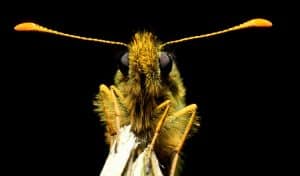
Firstly, Butterflies have ‘clubbed’ antennae (they appear to have little lumps on the end) while very few moths do.
Secondly, Moths have a small spine-like structure called a ‘Frenulum’ projecting from the base of the hind wing, which helps hold the hindwings and the forewings together while the insect is flying. Only one Butterfly in the world has a ‘Frenulum’ and that is an Australian Skipper – the rest have a ‘Humeral lobe’ to hold the wings together instead.
Between these two characteristics you can always tell which is which.
Butterflies and moths are easy to recognise, they have large wings and long, sometimes feathery antennae. Mostly moths fly at night and butterflies fly during the day, but some moths fly during the day also. The most commonly seen are the Hummingbird Hawkmoths, or Sphinx Moths.

The lepidoptera have a metamorphic life cycle, meaning that they start life as an egg which hatches into a small larvae. Often the first thing it does is to eat its egg shell, after this it normally sticks to vegetation, though a few species are carnivorous.
The larvae, commonly called a caterpillar, is an eating machine. It is often very attractively coloured, sometimes cryptically so (and sometimes, if it is poisonous, warningly so). Whichever, they are fun to watch.
Caterpillars grow quickly in most cases, as all they do is eat and hide from predators. Once the caterpillar is fully grown, it forms a pupa. The pupa is often called a cocoon for moths and a chrysalis for butterflies, this is because the butterfly pupa is often shiny like a crystal.
Inside the pupa, a miracle happens and the worm-like caterpillar turns into an adult butterfly or moth – with delicate wings. This miracle is called metamorphosis and there is more about it below.
For more on different insect life cycles and how they work see Insect Life Cycles.
The moth with the largest wingspan is Thysania agrippina (Noctuidae) and the moth with the largest wing surface area is the Atlas moth Attacus atlas (Saturnidae). Different species of moths overwinter or aestivate at different lifecycle stages. Though in temperate climes, most moths overwinter as a pupae; some do so as a larvae, egg or adult.
Order Lepidoptera Description
Lepidoptera are described as Holometabolous insects (insects which have larvae that look nothing like the adults/imagos and having a complete metamorphosis with a pupal stage).
They possess two pairs of membraneous wings with few cross veins (though these may be absent in the females of some moths). The mandibles are present in the larvae, but nearly always absent in the imagos/adults in whom the principal mouthparts are a sucking tube or proboscis. These are formed from the maxillae, which is held curled up in a spiral under the head when not in use (in a number of species of Moths the mouthparts are all degenerate in the imagos and these do not feed at all).

The antennae are variable in length and may be quite complicated in some male moths. The imagos have two large compound eyes with as many as 6,000 omatidium and two ocelli, while the larva often have simple ocelli. The wings and body of the imagos are covered in scales and the body of the larva are generally covered in hairs (though these may be very fine and short).
The salivary glands of the larvae have become modified to form the silk glands. The larvae are ‘eruciform’ (which means they look like a caterpillar) and in most cases have 13 body segments, with three pairs of jointed legs on the first three segments (which are roughly equivelent to a thorax in the imago).
Segments 3 to 6 of the abdomen (6,7,8,9 counting back from the head with the head as 0) each have a pair of unjointed pro- or false-legs; these end in a contractile pad surrounded by a ring of minute hooks. There is also a pair of unjointed claspers on the final segment.
Why do caterpillars have so many legs?
You may want to ask “Why do caterpillars have so many legs?”. In fact somebody already has, that’s why I have the answer ready.
If you watch a caterpillar walking and eating, you will see that it needs all its legs just to move around. The front three pairs will become the adult legs. The rest, usually five pairs (if you find one with more than five pairs then it is a sawfly larvae; Hymenoptera and not a Lepidopteran), are very useful to the caterpillar because they allow the middle and back-end of the caterpillar to hold onto the leaf or twig; while the front part tries to work out where to go next. They also make it harder for a bird to pull them off their food.
Some caterpillars which bore into wood or live inside a leaf have no legs at all. If you really want to know why, watch a caterpillar walk.
Color in Moths And Butterflies
Butterflies and many Moths are extremely colorful. They get their colors from the scales on their wings in two different ways.
Firstly, from pigments which the hollow scales contain and that are built out of a variety of substances. A clever thing to do is to use waste products, and this is just what Butterflies of the family Pieridae do. They make a number of pigments from ‘Uric Acid‘ – one of these ‘Xanthopteryn’ (C6H5O2N5) and is what gives the Brimstone its lovely yellow color.
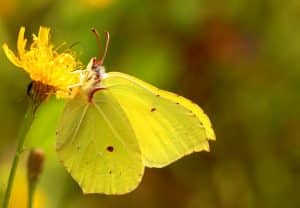
Secondly, as a result of changing the frequency of the light waves as they are reflected off the wing. Either as a result of a series of small ridges (less than one thousandth of an inch apart) which cause partial diffraction of the light waves that hit them; or as a result of ‘interference’ phenomena.
Interference phenomemna are caused by the light passing twice through (once on the approach and once on the departure) the walls of the scales of the wings. In these cases, the scales are built up of a series of very fine films each two of which sandwich a second substance that has a slightly different ‘refractive index’.
The Refractive Index is the degree to which light is bent as it passes from one substance into another at an angle. The bending occurs because the light has different velocities in each substance.
This is also what causes a stick standing half in the water and half in the air – to appear bent, when you know it is straight. Light travels slower in water than it does in air.
Though generally not as bright as butterflies, moths do make use of colour in a variety of ways.
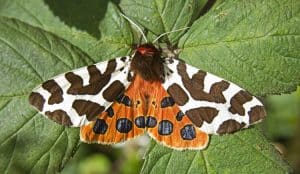
In day flying species like Tigers and Burnets, colour is important in informing potential predators that they are bad tasting and possibly poisonous – both as an adult and as a caterpillar. For most other moths, colour is used as camouflage in order to protect the resting moth from predators by concealing it.
Most moths are cryptically coloured to:
- blend in with their background, i.e. the Shoulder Stripe Anticlea badiata or the March Moth Alsophila Aescularia;
- to resemble parts of a plant, such as the Poplar Hawk Moth Lathoe populi or the Buff Tip Phalera bucephala; or
- to resemble other animals, such as the the Lunar Hornet Moth Sesia bembiciformis which resembles a wasp.
Many moths have evolved to resemble a bird dropping, either as an adult or as a larva or both. A bird dropping is something that a bird would never eat.
An even more extreme example of mimicry, is the caterpillar of the Lobster Moth – which possesses a warty nobly look. This allows it, when alarmed, to strike a pose waving its elongated forelegs around – giving it the appearance of an ant. Combined with this they can squirt formic acid onto an aggressor from a special gland in the 1st thoracic segment, which greatly enhances the mimicry.
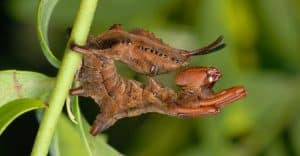
Many other caterpillars are mimics of one thing or another, using a variety of devices such as false and enlarged eyes to scare a predator.
Colour can also be used to confuse predators. Some moths, like the different Yellow Underwings (Noctuidae) have brightly coloured hind wings; these are only visible during flight. Therefore a bird which sees a moth like these, which has been forced to fly a short distance during the day, will have its focus drawn to the brightly coloured underwings.
When the moth quickly finds a new roost, it closes it wings and effectively becomes invisible – because the bird is looking for the bright orange moth, not the dull leaf-coloured one sitting very still on the ground.
Other moths and butterflies use false eyes on the hindwings as a method of startling a potential predator. Close approach to one of these moths results in sudden unveiling of the hind wings – creating the sudden appearance of a large-eyed owl, opening its eyes and about to be quite annoyed at any intrusion into its sleep!
Moth And Butterfly Metamorphosis
You may ask, how does a caterpillar become a Moth or a Butterfly?
The answer to this can actually get quite complicated, but basically what happens is this.
When the caterpillar has eaten enough, it turns into a pupa (more about this later on because it is different for different groups of Lepidoptera). To do this it stops eating and finds somewhere safe, here it becomes very still (pupa never eat and seldomly move at all). It then moults its skin, the same as it does when it is growing, only instead of another larval skin it secretes a pupal skin (inside its old larval skin) that is much thicker and stronger.
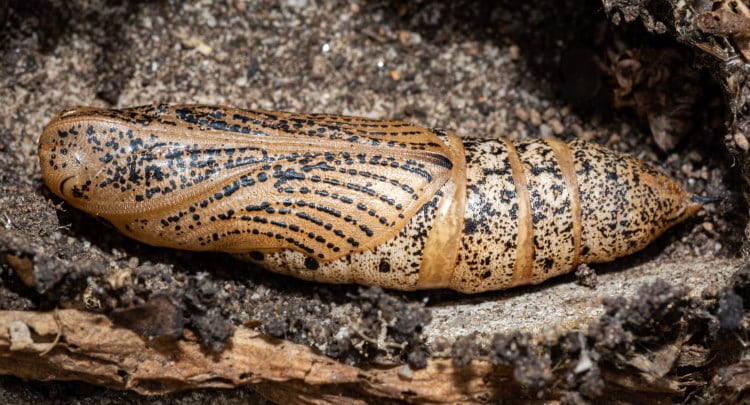
Generally this pupa then breaks out of the old larval skin, though in many moths the pupa remains inside the old larval skin. You can often find the remains of the caterpillar skin around the tail of a Butterfly pupa.
All that is fairly straight forward, where it gets tricky is how the caterpillar inside its new pupal case changes itself into a Butterfly or Moth. The first thing that happens is that a lot of the caterpillar’s old body dies. It is attacked by the same sort of juices the caterpillar used in its earlier life to digest its food.
It would not be far wrong to say the caterpillar digests itself from the inside out; this process is called “histolysis”.
Not all the tissue is destroyed however, some of the insect’s old tissue passes on to its new self. The amount that does this varies between different insects – and is not very much in the Lepidoptera.
There is one particular sort of tissue left. In a number of places in the insect’s body are collections of special formative cells – which have played no part in the insect’s larval life and have stayed hidden or protected during this partial death. Each of these groups of cells is called an “imaginal bud” or a “histoblast”.
The job of these histoblasts is to supervise the building of a new body, out of the soup that the insect’s digestive juices have made of the old larval body. This they do using the same biochemical processes that all insects use to turn their food into part of their bodies.
This rebuilding process is called “histogenesis”. During this time the insect is very vulnerable because it cannot run away. This is why insects try to choose somewhere safe to hide away when they are going through this incredible change. Etill, I think you have to be very brave to be a Caterpillar and become a Butterfly or a Moth!
Many people ask the question “What do moths eat?”. The answer, as you will see, is quite diverse.
Though no moths live in the sea, they can be found in most other habitats. From the seashore, Sand Dart Moth (Agrotis ripae), whose larvae feed on Sea Rocket (Cakile maritima) on sandy shores; or the Dew moth (Setina irronela) whose lavae feed on wave splashed lichens on rocky shores, to the highest vegetated parts of mountains.
There are a number of moths in the UK, for instance, who live up at the tops of our rather low mountains – because their larvae feed only on Bearberry Arctostaphylos uva-ursi i.e. The Netted Mountain Moth Isturgia carbonaria
The majority of moth larvae live between these habitat extremes, but they still feed on a great variety of substances -including other caterpillars, fungi and dead animal matter (many Tineidae), fox faeces (Monopis weaverella) and of course plant matter.
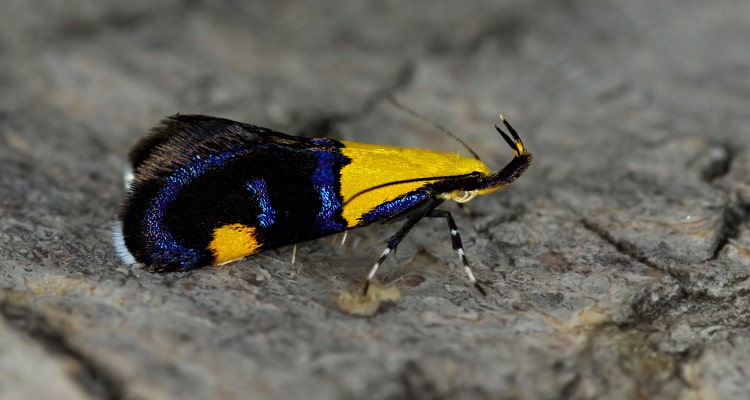
Though most moths feed on living plant materia, many (particularly the Oecophoridae) feed on dead plant matter and thus play an important role in nutrient recycling. Plant feeders range from those whose larvae are so small they can live and feed between the upper and lower surfaces of a leaf, to giants more that 6 inches (15cm) long that can strip a whole leaf from a tree in minutes.
However they do not all feed on leaves. All parts of the plant are used by some moths, even the roots i.e. Large Yellow Underwing Noctua pronuba and the wood of trees i.e. Hornet Clearwing Sesia apiformis.
Other species eat a lot by being numerous. The Winter Moth Operophtera brumata can defoliate whole Oak trees, and the Gypsy Moth, Lymantria dispar (deliberately introduced to N. America in 1870 as a potential source of silk) is a major pest of deciduous trees.
Many caterpillars feed on only a few species of plants (this is called oligophagy) but some, for various reasons, feed on a wide variety of plants (this is called polyphagy). Humans are polyphagous.
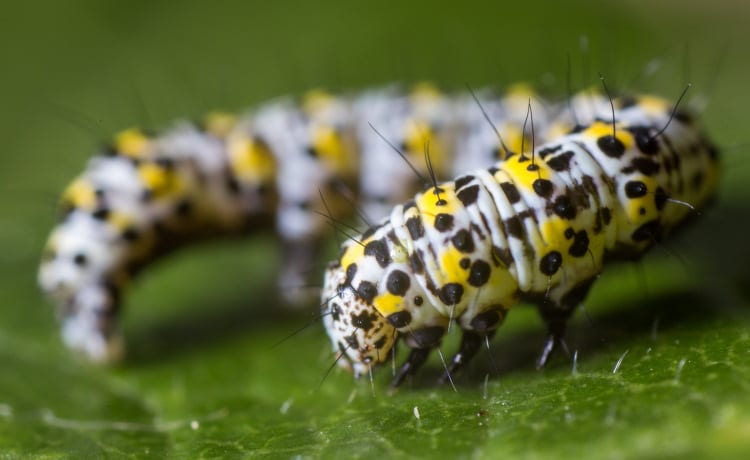
Adult moths feed mostly on nectar, which is why they are often useful pollinators – when they feed at all. Many moths, such as the large and beautiful Cecropias of North America, do not feed at all as adults.
More appealing to our formicatory (note an ‘m’ not an ‘n’) nature are the extremes, such as those which feed on animal tears or lachrymal fluids (tears).
This is termed lachryphagy and an example is Lobocraspis griseifusa, which feeds on the tears of buffalo in Asia. Even stranger perhaps are those members of the family Noctuidae who have evolved a proboscis with serrations and/or spines, which can be used to pierce skin. Either the skin of fruits to feed on fruit juice i.e Ophiusa tirhaca, or the skin of animals to feed on blood i.e. Calyptra minuticornis.
Moths have always fascinated modern man – and there are more amateur Lepidopterists, than there are amateurs studying any other insect order.
Some have even featured in movies, such as the Death’s Head Hawk Moth Acherontia atropos – whose name is derived from the Greek ‘Acheron’ (the river of pain in the underworld). Atropos was the one of the 3 fates whose job it was to cut the thread of life, of a person whose time has come to die.
Mankind and moths have been living together for a long time. Probably clothes moths – whose larvae like to feed on organic matter and who would therefore have enjoyed mankind’s habit of lining his sleeping places with animal skins – would have been among the earliest of lepidoptera pests.
But even before that, man would have been aware of moths as food. In Australia, the Aborigines have enjoyed a feast on aestivating adult Bogong Moths Agrotis infusa and on the larvae (Witjuti Grubs) of various members of the Cossidae and Hespalidae families – commonly known as Ghost Moths.
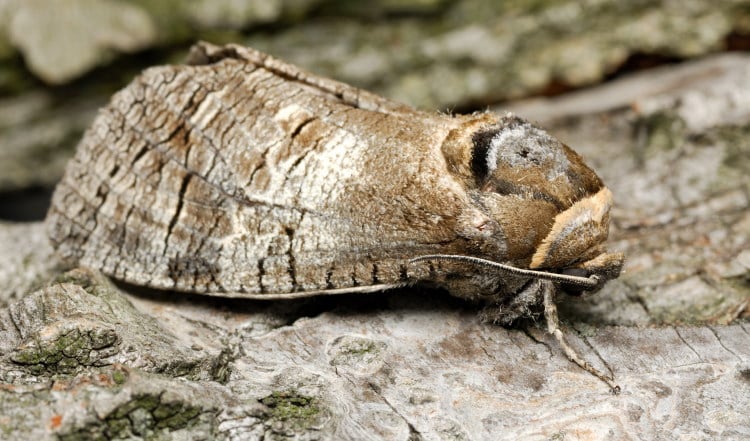
In ancient Rome, the larvae of the Goat moth Cossus cossus was specially bred as a table delicacy. Even today, the natives of the Transvaal apparently prefer Mopane worms to beef; Mopane worms being the larvae of the Emperor Moth Gonimbrasia belina .
These are so commonly eaten that you can by them tinned in some parts of Africa. In Africa as a whole, more than a dozen species of moth larvae are used as food. Gullan and Cranston 1994 claim that, even today in northern Zambia, caterpillars are the most important source of protein.
Man has also, of course, had a long relationship with Bombyx mori the Oriental Silk Moth – often referred to as the Silk Worm. This voracious devourer of Mulberry leaves has been in cultivation for over 4,700 years – and is now so dependant on Mankind, that they can no longer survive in the wild.
In 1989, silk production around the world was about 74 thousand tons (which adds up to not only a lot of money, but also a lot of Mulberry leaves).
The Silk Worm is one of the only two insects ever to have the death penalty imposed on anyone caught smuggling it out of its native country – in this case China.
This gives you some idea of how valuable it was considered to be by the governments of the time. The other insect so honoured was the Cochineal Insect Dactylopius coccus from Mexico.
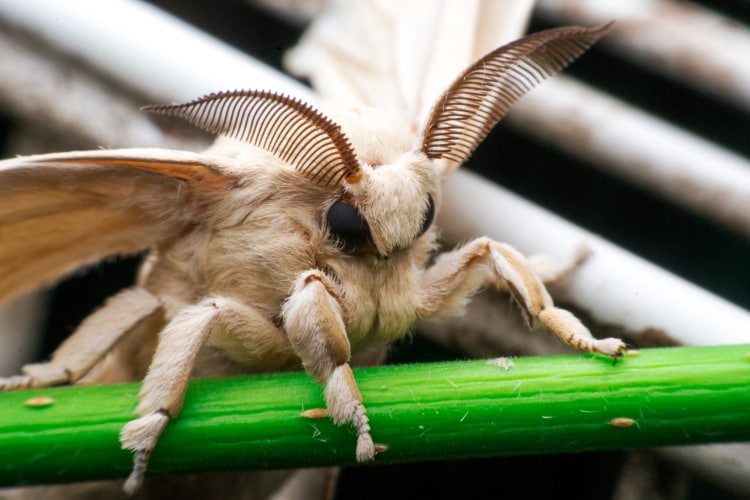
Moths feature most commonly in peoples’ consciousness these days as pests; their larvae eat things, in some cases things we do not want them to. About 30 species are major pests of stored food products. These mostly arise from 5 families (Gelechiidae, Oecophoridae, Tinaeidae, Galleriidae and Phycitidae), most of these are small species which can in some cases have numerous generations in a year.
For instance the Tropical Warehouse Moth Ephestia cautella, has a minimum life cycle of 25 days. Considering that a female can lay 300 eggs, it is easy to see how an infestation can quickly grow – one gravid female can give rise to more than 150 thousand million other moths in less than six months.
Apart from pests of stored food products, there are clothes moths and their relatives who eat our carpets and jumpers; cutworms that eat the roots of our lawns; as well as Budworms, Bagworms and Fruitworms feeding on our plants.
Though this may sound like an army hammering at our doors, it is important to remember that most moths are not pests.
On the beneficial side moths are useful pollinators of many plants, supply food for many other animals from bears to birds, and even supposedly help us predict the weather.
Those who believe this claim that the Banded Woolybear, which is the larvae of Isia isabella a species of Tiger Moth, indicate the weather of the coming winter by the thickness of the red band, i.e. the thinner the band, the worse the winter is going to be. There does not yet appear to be any scientific evidence to support this theory, unfortunately.
Moth Migration And Dispersion
Moths disperse for the same reasons as all other insects; to avoid competition, to find food, to find suitable egg laying sites and to find mates. Dispersal also helps keep the population from getting weak through inbreeding. Most moths disperse as adults, but in some species the females are wingless and hence can not disperse very far.
In these species, the larvae can be the dispersive stage. First instar larvae can go ballooning on a silken thread, though, in this way, many die before enough reach a suitable host plant to keep the population healthy i.e. Gypsy Moth.
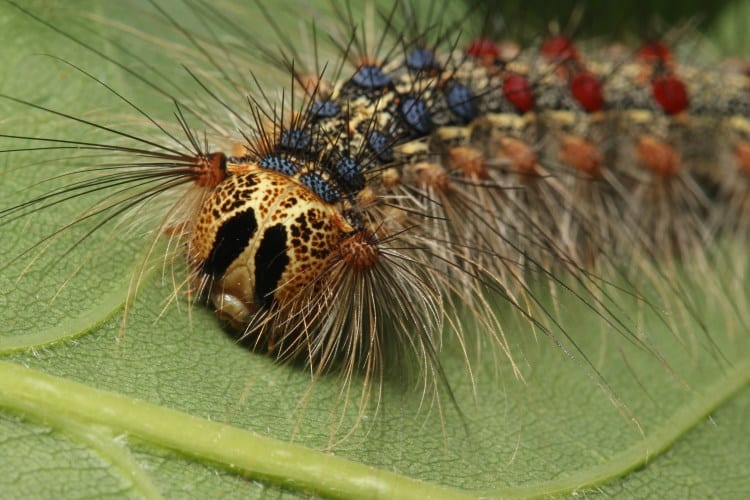
Others overcome the food shortage problem by feeding on a wide variety of plants i.e. the Belted Beauty Lycia zonaria.
Much more unusual is moth Acanthopsyche atra, in which the eggs within the body of the female will survive her being eaten by a bird – the eggs pass out with the droppings and then hatch.
Migration is an not uncommon fact in the moth world and there are quite a number of moths that make the crossing from mainland Europe to the UK regularly every year. Some of these are quite small, though not as small as the hoverflies and aphids which also migrate across the English Channel.
Moth migration occurs mostly as a result of overcrowding i.e. the African Army Worm Spodoptera exempta, in which larval crowding results in adults that are more prone to migrating. Or as a regular movement to and from an overwintering or aestivating habitat i.e. the Bogong Moth Agrotis infusa.
However some moths seem to migrate every year, for reasons we do not fully understand i.e. the Diamond Back Moth Plutella xylostella. Most species which migrate do so in a pre-reproductive state; this is particularly useful for the females, as it means that they do not have to carry a large load of eggs that would reduce the distance they could travel.
Orientation
Moths are known to use a mixture of stimuli to keep their direction when migrating. Though physical landmarks are used in ordinary day-to-day flights, within a given area these are of little use during migration across previously unknown habitats.
Instead, moths use either the Earth’s magnetic field or the light of the moon and stars (or both) to navigate. Experiments suggest that the Large Yellow Underwing can detect and respond to the Earth’s magnetic field, though the mechanism behind the detection is as yet unknown.
Other work has shown that they respond to the position of the sun and the moon, even making corrections for the changing position of the moon with time to keep their course straight. How they know or why they choose a particular direction is unknown.
Moths and Candles (or Light)
Many people are fascinated by the obvious attraction of moths to candles and other forms of lighting. The fact of this attraction has been used for many years to assist in the study of the distribution and movement of moths. However it should be noted that, in general, far more male moths are caught at light traps than female ones – and that some species do not come to light at all.
The reasons behind the attraction of moths to light are not well understood.
Some people have suggested that it is an overriding of an attraction to the moon, which would help moths find the glades within a forest where flowers and larval food plants are more likely to abound. However, as moths do not fly at the moon, this would seem to have a few holes in it as a scientific explanation.
Another suggestion is that the intensity of the light source causes the moths to perceive the centre of the light as a darkness with their peripheral vision (and that moths seek this centre in order to escape what would look, to them, like a diffuse halo of light).
As they approach the light source, their relationship to the source changes causing them to change their direction. This self-correcting feedback cycle results in the erratic and sometimes spiral approach to light observed in many moths.
Whether this is true or not, I do not know. But it seems likely that the moths’ highly sensitive light detecting abilities could easily be overloaded by the intense light sources created by man – and that this in someway is the cause of the observed phenomena.
Moth Hearing and Sound Production
Moths can hear – both each other and other animals (particularly the ultrasound of bats, the main predators of moths as adults). Moth ears are mostly tympanum (a membrane stretched across a space with sensors) based.
Moths locate their ears on a number of different parts of their bodies. The Pyralidae, Geometridae, Uraniidae, and Drepanidae have ears on their abdomen. The Noctuidae, Arctiidae, Doidae and Notodontidae have ears on their thorax. The Siculodinae have hears on their wings and the Sphingidae have ears that are not based on a tympanum and which hear only ultra sound on their labial palps.
The larvae of many butterflies and moths appear to be sensitive to sound, through special sensory hairs located on or near their heads.
Moths can produce sound in a number of ways. The most common method is by stridulation of the wings against the hind legs; specially sclerotised parts of the limbs scrape against each other, setting up vibrations which cause the sound, i.e. Pemphigostola synemonisitis. Stridulation of wings against thorax occurs in several species such as Xyluties durvillei.
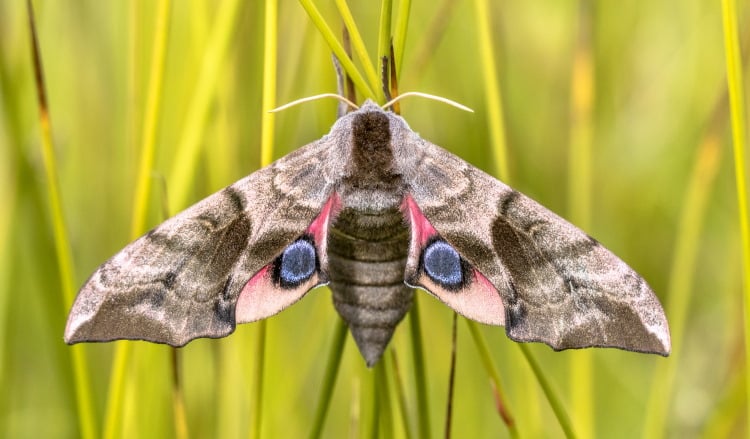
Rather more unusual is stridulation resulting from the male scraping a specially adapted part of his genitalia against his abdomen, as seen in the Australian Syntonarchia eriastris. This is also seen in the piping produced by the Adult Death’s Head Hawk moth by expelling air through its proboscis, or the vibrating together of castanet-like structures on the wings of Helicoverpa zea.
A number of nocturnal moths which are distasteful, use ultra sound in a similar way that diurnal species use colour. When they detect an approaching bat they emit a short burst of ultra sound that bats learn to identify with distastefulness – in a similar way that birds learn not to eat Cinnabar Moth Tyria jacobaeae.
Moth Scent And Pheromones
Pheromones are volatile chemicals which can be detected in the air. In moths, as with most insects, detection is done by the antennae. In most cases, it is the male who has the job of finding the female (males often have larger and more feathery antennae than the females).
Generally speaking therefore, females release pheromones to attract males from a distance. While males release pheromones only when close to the females, in order to sexually stimulate her.
As always in nature, there are exceptions. In the American Saltmarsh Moth Estigmene acrea, small groups of males get together to release a pheromone which attracts females. Whoever it is releasing the attractant, they have to sit still once they have started ‘calling’, in order to give the other sex an opportunity to find them (as the path followed by the searcher is never a straight one and generally requires considerable adjustments in direction, before the sender is found).
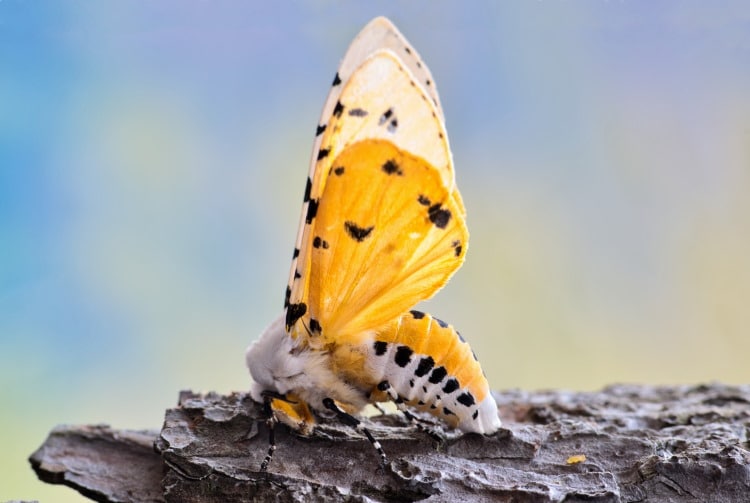
Though moths like the male Cercropia have been shown to be able to detect the scent of a female from many kilometres away, in most cases their attraction and detection generally works best over distances of less than a few hundred metres. This is still much more efficient than either sound or sight.
In females, the pheromones are normally released from special glands on the abdomen – either between segments 7 and 8, or segments 8 and 9. In males however, the scent glands can be located in a great variety of places.
Lepidoptera Taxonomy
The order Lepidoptera is divided into four suborders. One of these, the Ditrysia, contains 16 superfamilies – two of which, Papilionoidea and Hesperioidea contain all the Butterflies.
You can see the full Cladistic view at Lepidoptera on the Tree of Life.
Final Thoughts
Well, I hope you have found this an interesting little look into the world of the Lepidoptera! To get an even better look at these fascinating creatures, consider investing in a stereo zoom microscope.
Perhaps now you’d like to check out how to keep a pet butterfly or learn more about stick bugs.


